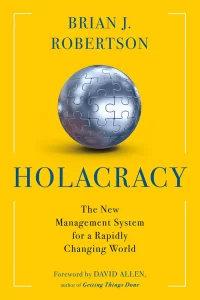Summary
Article 2 defines a list of “duties” that any partner in the organization is responsible for. It includes duties of transparency (e.g. upon request one must share what they’re working on), duties for processing (e.g. one must respond to requests for taking on new work and take it on, unless they decide not to, in which case they must explain why), and duties of prioritization (e.g. one must align with the strategy of the circle).
Business value
- Explicit and consistent duties for anyone in the organization. Adds clarity, consistency, and equality as to what people can expect from each other in terms of operational cooperation. These rules apply equally to everyone, whether CEO or junior employee.
- Increased transparency and accountability across the organization. Everyone can request transparency into anyone’s work.
- More difficult (and more visible) for anyone to play ‘political games’ through information hoarding or lack of communication.
- Increased clarity into how to prioritize one’s work vs. requests from others, one’s work vs. meetings, how to handle conflicting deadlines, etc.
Key Features
Below is a summary of key elements from this module. For the actual rules, please see Constitution – Article 2.
Duty of Transparency
Defines basic responsibilities and expectations between co-workers to share information about the work they are doing. Applies to everyone equally to ensure optimal communication and transparency organization-wide.
Why it’s useful:
- Explicit expectations so everyone knows what they can request from each other, without fear of being “out of bound”.
- Encodes best practices for effective cooperation between co-workers.
- Increases accountability.
- Reduces risk of information silos or using information as political currency.
Duty of Processing
Defines basic best practice expectations on everyone for how they process and respond to requests from co-workers.
Why it’s useful:
- Increases accountability.
- Ensures that people accept requests to work on things that makes sense for their role to do, even in a self-management context where the work is not “assigned” to them.
- Ensures that access to Domains (things exclusively controlled by a role) remains open to others when it makes sense. Prevents Domains from becoming someone’s turf for ego/political reasons.
Duty of Prioritization
Defines specific guidelines for how one should prioritize their work, allowing both autonomy of prioritization and limits to that autonomy to ensure collective alignment of work effort.
Why it’s useful:
- Protects against communication bottlenecks by ensuring internal communication is prioritized.
- Ensures workers prioritize any work that’s a priority for the circle over other work, even if that other work is a higher priority for their specific role.
- Provides a mechanism to allow people to treat tactical and governance meetings as optional, while still making sure they attend if others need them (only relevant if you adopted Module 3 or Module 5).
- Clarifies how workers should treat deadlines – as a statement of prioritization instead of a timestamp to blindly follow.
Relational Agreements
Defines the construct of Relational Agreements that are used for agreements between people outside of their roles. Holacracy’s organizational structure (Module 1) defines a structure of roles, which are only “organizational functions” differentiated from the people assigned to them. Where do we then place expectations on people as people? E.g. dress code, cell phone usage during meetings, work hours, etc.
That is what Relational Agreements are for: creating agreements between people, or between people and the organization, about specific behavioral expectations related to the work but not part of roles definitions.
Why it’s useful:
- Creates a space for agreements with people as people, which lessens the risk that people will try to use role definitions, governance, or peer pressure to meet that need.
- Integrates interpersonal best practices by limiting the applicability of Relational Agreements to behaviors, not abstract ideas or principles.
- Relational Agreements may only be requested, not demanded, which enshrines a clean and honoring relationship between people and between people and the organization.
Alternatives to Holacracy’s Rules of Cooperation
Every organization has some “rules of cooperation”, whether or not they adopt Holacracy’s version. In most cases, they are mostly unwritten and inconsistent norms that are “part of the culture.” For example, we know we can request updates on his work from Chris, but the same request makes Erik feel micromanaged and he responds with irritation so it’s best to avoid it. People learn these norms over time through observation and trial and error. They can easily be a source of misaligned expectations and conflicts between coworkers.
If you choose not to adopt Holacracy’s Rules of Cooperation, it is nonetheless useful to write down your current rules of cooperation and include them in your constitution. Even if they merely explicitly point to implicit rules, at least that fact is made explicit. It also makes it easier to modify them in the future. For example:
Everyone shall cooperate with one another following the same norms that we have developed over the course of the company’s history. In doubt, ask someone who has worked here for a long time. If one of these norms conflicts with the modules of the constitution we have adopted, the constitution overrides the norm.
